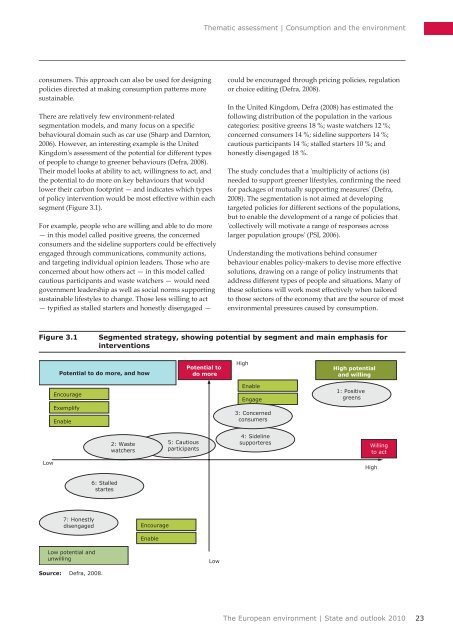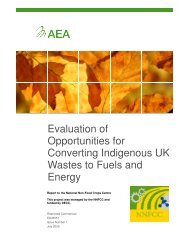Consumption and the environment (SOER2010) - European ...
Consumption and the environment (SOER2010) - European ...
Consumption and the environment (SOER2010) - European ...
You also want an ePaper? Increase the reach of your titles
YUMPU automatically turns print PDFs into web optimized ePapers that Google loves.
Thematic assessment | <strong>Consumption</strong> <strong>and</strong> <strong>the</strong> <strong>environment</strong><br />
consumers. This approach can also be used for designing<br />
policies directed at making consumption patterns more<br />
sustainable.<br />
There are relatively few <strong>environment</strong>-related<br />
segmentation models, <strong>and</strong> many focus on a specific<br />
behavioural domain such as car use (Sharp <strong>and</strong> Darnton,<br />
2006). However, an interesting example is <strong>the</strong> United<br />
Kingdom's assessment of <strong>the</strong> potential for different types<br />
of people to change to greener behaviours (Defra, 2008).<br />
Their model looks at ability to act, willingness to act, <strong>and</strong><br />
<strong>the</strong> potential to do more on key behaviours that would<br />
lower <strong>the</strong>ir carbon footprint — <strong>and</strong> indicates which types<br />
of policy intervention would be most effective within each<br />
segment (Figure 3.1).<br />
For example, people who are willing <strong>and</strong> able to do more<br />
— in this model called positive greens, <strong>the</strong> concerned<br />
consumers <strong>and</strong> <strong>the</strong> sideline supporters could be effectively<br />
engaged through communications, community actions,<br />
<strong>and</strong> targeting individual opinion leaders. Those who are<br />
concerned about how o<strong>the</strong>rs act — in this model called<br />
cautious participants <strong>and</strong> waste watchers — would need<br />
government leadership as well as social norms supporting<br />
sustainable lifestyles to change. Those less willing to act<br />
— typified as stalled starters <strong>and</strong> honestly disengaged —<br />
could be encouraged through pricing policies, regulation<br />
or choice editing (Defra, 2008).<br />
In <strong>the</strong> United Kingdom, Defra (2008) has estimated <strong>the</strong><br />
following distribution of <strong>the</strong> population in <strong>the</strong> various<br />
categories: positive greens 18 %; waste watchers 12 %;<br />
concerned consumers 14 %; sideline supporters 14 %;<br />
cautious participants 14 %; stalled starters 10 %; <strong>and</strong><br />
honestly disengaged 18 %.<br />
The study concludes that a 'multiplicity of actions (is)<br />
needed to support greener lifestyles, confirming <strong>the</strong> need<br />
for packages of mutually supporting measures' (Defra,<br />
2008). The segmentation is not aimed at developing<br />
targeted policies for different sections of <strong>the</strong> populations,<br />
but to enable <strong>the</strong> development of a range of policies that<br />
'collectively will motivate a range of responses across<br />
larger population groups' (PSI, 2006).<br />
Underst<strong>and</strong>ing <strong>the</strong> motivations behind consumer<br />
behaviour enables policy-makers to devise more effective<br />
solutions, drawing on a range of policy instruments that<br />
address different types of people <strong>and</strong> situations. Many of<br />
<strong>the</strong>se solutions will work most effectively when tailored<br />
to those sectors of <strong>the</strong> economy that are <strong>the</strong> source of most<br />
<strong>environment</strong>al pressures caused by consumption.<br />
Figure 3.1<br />
Segmented strategy, showing potential by segment <strong>and</strong> main emphasis for<br />
interventions<br />
Potential to do more, <strong>and</strong> how<br />
Potential to<br />
do more<br />
High<br />
High potential<br />
<strong>and</strong> willing<br />
Encourage<br />
Exemplify<br />
Enable<br />
Enable<br />
Engage<br />
3: Concerned<br />
consumers<br />
1: Positive<br />
greens<br />
2: Waste<br />
watchers<br />
5: Cautious<br />
participants<br />
4: Sideline<br />
supporteres<br />
Willing<br />
to act<br />
Low<br />
High<br />
6: Stalled<br />
startes<br />
7: Honestly<br />
disengaged<br />
Encourage<br />
Enable<br />
Low potential <strong>and</strong><br />
unwilling<br />
Low<br />
Source: Defra, 2008.<br />
The <strong>European</strong> <strong>environment</strong> | State <strong>and</strong> outlook 2010<br />
23








